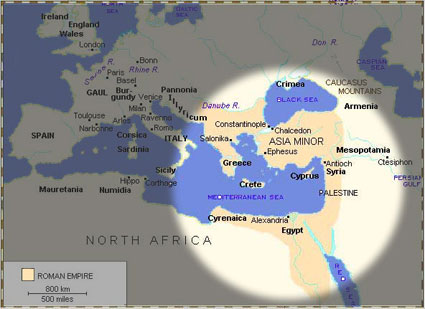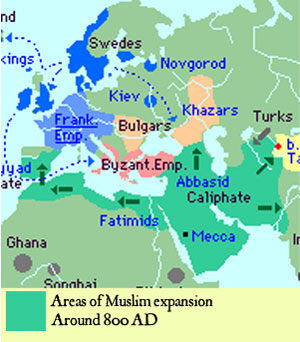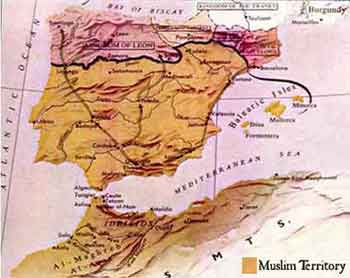In order to understand the Renaissance it's necessary to go back around 1000 years, a full
millennium, before the Renaissance began. While that may seem stretching things a bit, it's very easy to picture when you think of the Renaissance as a rebirth or a rediscovering of something lost. Then ask the questions, "What was lost?" "Who lost it?" Where was it?" It may also be necessary to realign one's conceptions with the facts as they are known to be and not as one might perceive them to be.
Setting the stage for the Renaissance
1. The decline of the Roman Empire
2. The establishment of feudalism
3. The iron hand of the Christian Church
4. The suppression of secular art and literature
5. The preservation of classical art and literature
6. The revelation of repressed learning
Here's the story:
It all begins with the Roman Empire.
At it's height the Roman Empire contained all the splendors and all the knowledge of the known civilized (i.e. Western and near-Eastern) world. There were no printing presses and all books were handmade individually. Yet there were 28 libraries boasting hundreds of thousands of books, many plundered from the libraries of conquered lands. The books were one-of-kind and in that sense
irreplaceable except through transcription, a slow and painstaking
procedure. Although Rome had a small literacy rate (partially due to the illiterate countries they assimilated), it did have public libraries and an education system, though a private one geared toward the sons of upper class parents.

[ map - The Roman Empire, 500 AD ]
As Rome expanded throughout the years, its influence spread and its knowledge increased, but, unfortunately, its ability to maintain itself became greatly reduced. Eventually, the West - what is now England, France, Spain, Germany - was overrun by local tribes and invaders, freeing itself from Roman rule. These peoples had little use for the preservation of Roman culture. The Eastern portion of the empire became based, not in Rome, but in
Byzantium, a city later called Constantinople, then Istanbul in what is now Turkey. The people in the Eastern Roman Empire considered themselves true Romans, but in reality they were a mixed bag of cultures.
The Byzantine Empire became the trove of learning. Under Constantine, after whom Constantinople was named, Christianity started becoming the accepted religion, effectively doing away with polytheism.

[ map - The Expansion of Muslim rule, 800 AD ]
Further east around this time, the Islamic prophet, Muhammad, had unified the Arab tribes under the religion of Islam. The Muslims were, and still are, great innovators and lovers of knowledge. As the Muslim influence grew and their armies conquered surrounding lands, they applied pressure to the Byzantine Empire. While the Muslims sidestepped Constantinople and swept across Northern Africa into Spain, there was some interaction between these great dynasties and the Muslims added the knowledge of the classical Greeks and Romans to their own. In fact, the Muslim preserved and restore a great
quantity of classical works. Meanwhile the Byzantine Empire became more Greek-centered and little of value was produced there. The Christian Church and feudalism became dominant features in Western Europe during this time. Feudalism filled the void left by the absence of Roman rule while the Church became the repository of learning, but not a very forthcoming one. This time became known as the Dark Ages and lasted up to the Renaissance. As the Muslims took over the Iberian Peninsula and moved to dominate the rest of Europe, Charles Martel's Frank army effectively ended any such dreams at Tours in 732 ensuring that Christianity remain the prevailing religion.
And when the smoke clears....
It's the 10th century. What was Rome survives in a small area around Constantinople, the center of the Byzantine Christian Church. The feudalistic society of Western Europe is dominated by the Roman Catholic Church where the centers of learning are the monasteries and peoples' lives revolve around work and religion. Surrounding Europe are the Muslims whose center of learning are the universities, the mosques and the libraries. But, while their laws are also repressive, unlike the Christian Church, the Islamic Church does not forbid or persecute other religions, though they do tax them (but this is more pragmatism than tolerance since the Muslims found it simpler to allow than to persecute differences) . The Muslim areas were like light on the
perimeter of dark Europe but all inroads into Europe had been blocked.
All throughout Europe land was divided into tiny states with no cohesion and no central government. This led to feudalism. This hierarchy or caste system relegated the common man to a lowly
subservient position. But the common man was doubly affected - first by the state and second by the church which played an equal role in his life.
As dismal as life was under feudalism, life under Muslim rule seemed much brighter in comparison. According to a BBC production on Religions and Ethics :
In the 10th century, Cordoba, the capital of Umayyad Spain, was unrivalled in both East and the West for its wealth and
civilization. One author wrote about Cordoba:
"there were half a million inhabitants, living in 113,000 houses. There were 700 mosques and 300 public baths spread throughout the city and its twenty-one suburbs. The streets were paved and lit... There were bookshops and more than seventy libraries."
Muslim scholars served as a major link in bringing Greek philosophy, of which the Muslims had previously been the main custodians, to Western Europe.
Muslims in medieval Spain also contributed to the advancement of technolgy and to the phenomenon referred to as the 12th century Renaissance.
Since most of the classical knowledge had been preserved by the Muslims, the Renaissance, which was a movement based on the effects of the rediscovery of these works, was directly affected by the interaction between the Christian and Islamic countries. Two events towards the end of the 12th century particularly precipitated the Renaissance though by hundreds of years since things moved much more slowly then - and the events were more a long series of events each with it's own common theme.
The Reconquista of Spain
According to historian James Burke, "...the event that must have done more for the intellectual and scientific revival of Europe was the fall of Toledo in Spain to the Christians, in 1105."

[ map - 10th Spain ]
By the 8th the Muslims had control of almost the entire Iberian Peninsula, but their control was gradually diminishing, mostly due to internal conflicts, but also because of the pressure from the North. Charlemagne pushed the Muslims back to Barcelona. During the 11th century, Leon, Castile, Navarre, and Aragón become separate, but allied, Christian provinces.
According to Burke, "In 1013 the great library in Cordova was destroyed. True to their Islamic traditions however, the new rulers permitted the books to be dispersed, together with the Cordovan scholars to the capital towns of small emirates." This library held over 600,000 volumes which became scattered among the small towns in the areas controlled by the Muslims.
But in 1085 King Alfonso VI, king of León and king of Castile, conquered Toledo, the old
Visigoth capital. * "The Spanish libraries were opened, revealing a store of classics and Arab works that staggered Christian Europeans." James Burke
explains further, "The subjects covered by the texts included medicine, astrology, astronomy pharmacology, psychology, physiology, zoology, biology, botany, mineralogy, optics, chemistry, physics, mathematics, algebra, geometry, trigonometry, music, meteorology, geography, mechanics, hydrostatics, navigation and history."
This was the treasure of Toledo more beguiling than gold. Scholars from the Christian lands flocked to Toledo where they established and funded a centre and system for translating these works from Arabic to Latin in which Jewish and Arab scholars read texts in Arabic, and recited them out loud in Castilian. Christian scholars listened to the spoken Castilian and wrote in Latin.
For a deeper and more descriptive explaination of value of these discoveries click here.
* Alfonso VI impressed the Arabs with his military savvy, but even more so as a keeper of his word. According to a Muslim legend he was challenged to a chess game with Ibn Ammar, a favourite of Al Motamid, the king of Seville. For stakes, Ibn Ammar put up his exquisite chess set and table - the one with which they played - while, allowing Ibn Ammar to name his prize if he won. Ibn Ammar won and, as his prize, he asked that Alfonso spare Seville from the fate of Toledo. Alfonso kept his word.
The Crusades
 The Crusades were, in effect, a defensive maneuver on the part of Christians. The Byzantine empire had been
whittled down by encroaching Muslim expansionists, leaving what was once the Roman Empire nothing more than Greece. The Muslim armies had swept through Palestine, Syria, and Egypt, all formerly Christian countries, the took over Northern Africa, Spain and Asia Minor - what is now Turkey, all formerly Christian territories. And finally, the last stronghold in the East, Constantinople, was so seriously threatened that Alexius Comnenus, or Emperor Alexius I, appealed to Pope Urban II for help. In turn, Pope Urban II, who recognized the long term threat that Islam poses to the Christian world, called for a Crusade obstensively to free the Holy Lands from Muslim rule. It's was probably not only his best course of action, but possibly his only course of action. Islam was a military religion at it's birth and ever since suckled on the blood of it's enemies. Despite it's great wisdom and love of learning and culture, it was rightfully feared by the Christian Church. The series of Crusades lasted from 1095 until 1272, resulting in neither freeing the Holy Lands nor stemming the Arab tide. While the Crusades in theory were a necessity, their execution was haphazard and ineffectual.
The Crusades were, in effect, a defensive maneuver on the part of Christians. The Byzantine empire had been
whittled down by encroaching Muslim expansionists, leaving what was once the Roman Empire nothing more than Greece. The Muslim armies had swept through Palestine, Syria, and Egypt, all formerly Christian countries, the took over Northern Africa, Spain and Asia Minor - what is now Turkey, all formerly Christian territories. And finally, the last stronghold in the East, Constantinople, was so seriously threatened that Alexius Comnenus, or Emperor Alexius I, appealed to Pope Urban II for help. In turn, Pope Urban II, who recognized the long term threat that Islam poses to the Christian world, called for a Crusade obstensively to free the Holy Lands from Muslim rule. It's was probably not only his best course of action, but possibly his only course of action. Islam was a military religion at it's birth and ever since suckled on the blood of it's enemies. Despite it's great wisdom and love of learning and culture, it was rightfully feared by the Christian Church. The series of Crusades lasted from 1095 until 1272, resulting in neither freeing the Holy Lands nor stemming the Arab tide. While the Crusades in theory were a necessity, their execution was haphazard and ineffectual.
What did result from the Crusades was a strengthening of the papacy, an increase in trade, and interaction between two groups of peoples normally separated by 1000's of miles and the realization that the world was a big and diverse place of which too little was known and experienced.
It's this sort of new way of thinking, a paradigm shift, so to speak, that helped pave the way towards the Renaissance.
References and Related Links
The Alexiad of Anna Comnena (daughter of Alexius I of Constantinople)
Sparknotes Encyclopedia
A Brief Look at the Renaissance
The Book of Chess by Alfonso X, el Sabio
Muslim Spain and European Culture
Muslim Spain and Islamic Science
Crusades: timeline
The Real History of the Crusades
Text to Gibbon's Rise and Fall of the Roman Empire
Convivencia: Jews, Muslims, and Christians in Medieval Spain: Jews, Muslims, and Christians in Medieval Spain Vivian B. Mann, Thomas Glick
by Vivian B. Mann, Thomas Glick
1992, George Braziller, publisher
|
|



 The Crusades were, in effect, a defensive maneuver on the part of Christians. The Byzantine empire had been
whittled down by encroaching Muslim expansionists, leaving what was once the Roman Empire nothing more than Greece. The Muslim armies had swept through Palestine, Syria, and Egypt, all formerly Christian countries, the took over Northern Africa, Spain and Asia Minor - what is now Turkey, all formerly Christian territories. And finally, the last stronghold in the East, Constantinople, was so seriously threatened that Alexius Comnenus, or Emperor Alexius I, appealed to Pope Urban II for help. In turn, Pope Urban II, who recognized the long term threat that Islam poses to the Christian world, called for a Crusade obstensively to free the Holy Lands from Muslim rule. It's was probably not only his best course of action, but possibly his only course of action. Islam was a military religion at it's birth and ever since suckled on the blood of it's enemies. Despite it's great wisdom and love of learning and culture, it was rightfully feared by the Christian Church. The series of Crusades lasted from 1095 until 1272, resulting in neither freeing the Holy Lands nor stemming the Arab tide. While the Crusades in theory were a necessity, their execution was haphazard and ineffectual.
The Crusades were, in effect, a defensive maneuver on the part of Christians. The Byzantine empire had been
whittled down by encroaching Muslim expansionists, leaving what was once the Roman Empire nothing more than Greece. The Muslim armies had swept through Palestine, Syria, and Egypt, all formerly Christian countries, the took over Northern Africa, Spain and Asia Minor - what is now Turkey, all formerly Christian territories. And finally, the last stronghold in the East, Constantinople, was so seriously threatened that Alexius Comnenus, or Emperor Alexius I, appealed to Pope Urban II for help. In turn, Pope Urban II, who recognized the long term threat that Islam poses to the Christian world, called for a Crusade obstensively to free the Holy Lands from Muslim rule. It's was probably not only his best course of action, but possibly his only course of action. Islam was a military religion at it's birth and ever since suckled on the blood of it's enemies. Despite it's great wisdom and love of learning and culture, it was rightfully feared by the Christian Church. The series of Crusades lasted from 1095 until 1272, resulting in neither freeing the Holy Lands nor stemming the Arab tide. While the Crusades in theory were a necessity, their execution was haphazard and ineffectual.